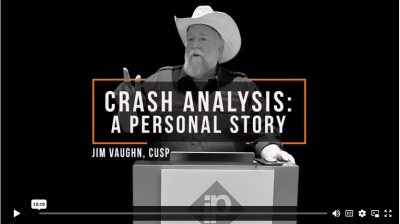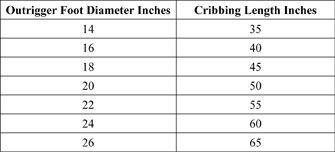Tag: Train the Trainer 101
Training Users of Aerial Lifts
Written by Jim Vaughn, CUSP on . Posted in Train the Trainer 101.
ATVs and UTVs: Minimizing the Hazards
Written by Jim Vaughn, CUSP on . Posted in Train the Trainer 101.
Opening a Can of Worms
Written by Jim Vaughn, CUSP on . Posted in Train the Trainer 101.
Crash Analysis: A Personal Story
Written by Jim Vaughn, CUSP on . Posted in Train the Trainer 101.
The Skinny on Confined Spaces
Written by Jim Vaughn, CUSP on . Posted in Train the Trainer 101.
Traffic Cones and Flashing Lights
Written by Jim Vaughn, CUSP on . Posted in Train the Trainer 101.
A Close Look at Step and Touch Potentials
Written by Jim Vaughn, CUSP on . Posted in Worksite Safety, Train the Trainer 101.
Safety Signs and Sign Policy
Written by Jim Vaughn, CUSP on . Posted in Worksite Safety, Train the Trainer 101.
Containing Contagions in Close Quarters
Written by Jim Vaughn, CUSP on . Posted in Worksite Safety, Train the Trainer 101.
Eating the Elephant
Written by Jim Vaughn, CUSP on . Posted in Worksite Safety, Train the Trainer 101.
Who is Your Customer?
Written by Jim Vaughn, CUSP on . Posted in Worksite Safety, Train the Trainer 101.
Writing an ATV/UTV Operating Safety Policy
Written by Jim Vaughn, CUSP on . Posted in Worksite Safety, Train the Trainer 101.
A Practical Guide to Using Outrigger Pads
Written by Jim Vaughn, CUSP on . Posted in Worksite Safety, Train the Trainer 101.
Understanding Radio Frequency Energy Exposure
Written by Jim Vaughn, CUSP on . Posted in Worksite Safety, Train the Trainer 101.
Trailers, Brakes and Common Usage Errors
Written by Jim Vaughn, CUSP on . Posted in Worksite Safety, Train the Trainer 101.
A Practical Review of the ANSI A92.2 Standard
Written by Jim Vaughn, CUSP on . Posted in Worksite Safety, Train the Trainer 101.
A Practical Review of the C2-2017 National Electrical Safety Code
Written by Jim Vaughn, CUSP on . Posted in Worksite Safety, Train the Trainer 101.
Arc Flash and Face Masks
Written by Jim Vaughn, CUSP on . Posted in Worksite Safety, Train the Trainer 101.
Train the Trainer 101: The ABCs of Grounding Mobile Equipment
Written by Jim Vaughn, CUSP on . Posted in Worksite Safety, Train the Trainer 101.
Train the Trainer 101: FMCSR Awareness
Written by Jim Vaughn, CUSP on . Posted in Worksite Safety, Train the Trainer 101.
Train the Trainer 101: Know OSHA – or Pay the Price
Written by Jim Vaughn, CUSP on . Posted in Worksite Safety, Train the Trainer 101.
Train the Trainer 101: Rigor and Discipline
Written by Jim Vaughn, CUSP on . Posted in Worksite Safety, Train the Trainer 101.
Train the Trainer 101: OSHA, Training and Certification
Written by Jim Vaughn, CUSP on . Posted in Worksite Safety, Train the Trainer 101.
Train the Trainer 101: Manufacturer Warnings and OSHA-Compliant Safety Performance
Written by Jim Vaughn, CUSP on . Posted in Worksite Safety, Train the Trainer 101.
Train the Trainer 101: Root Cause Analysis, Training and Lessons Learned
Written by Jim Vaughn, CUSP on . Posted in Worksite Safety, Train the Trainer 101.
Train the Trainer 101: Telcom Workers Don’t Need FR – Or Do They?
Written by Jim Vaughn, CUSP on . Posted in Worksite Safety, Train the Trainer 101.
Train the Trainer 101: Solving PPG – Without Electrical Math
Written by Jim Vaughn, CUSP on . Posted in Worksite Safety, Train the Trainer 101.
Train the Trainer 101: Are Those Tools and Equipment Approved?
Written by Jim Vaughn, CUSP on . Posted in Worksite Safety, Train the Trainer 101.
Train the Trainer 101: The Value of a Site-Specific Health and Safety Plan
Written by Jim Vaughn, CUSP on . Posted in Worksite Safety, Train the Trainer 101.
Train the Trainer 101: Enforcement of Vehicle Weight and Load Securement Rules
Written by Jim Vaughn, CUSP on . Posted in Worksite Safety, Train the Trainer 101, Equipment Operations.
Train the Trainer 101: Current in Grounds Can Kill
Written by Jim Vaughn, CUSP on . Posted in Worksite Safety, Train the Trainer 101.
Train the Trainer 101: Lessons from Puerto Rico
Written by Jim Vaughn, CUSP on . Posted in Worksite Safety, Train the Trainer 101.
Train the Trainer 101: No Windows
Written by Jim Vaughn, CUSP on . Posted in Worksite Safety, Train the Trainer 101.
Train the Trainer 101: Practical Aviation for Power-Line Applications
Written by Jim Vaughn, CUSP on . Posted in Safety Management, Worksite Safety, Train the Trainer 101.
Train the Trainer 101: Training and Verification Requirements for the Safety of Electric Utility Workers
Written by Jim Vaughn, CUSP on . Posted in Safety Management, Worksite Safety, Train the Trainer 101.
Train the Trainer 101: Addressing Common Fall Protection Questions and Concerns
Written by Jim Vaughn, CUSP on . Posted in Safety Management, Worksite Safety, Train the Trainer 101.
Train the Trainer 101: The New Walking-Working Surfaces Final Rule
Written by Jim Vaughn, CUSP on . Posted in Safety Management, Worksite Safety, Train the Trainer 101.
Train the Trainer 101: Understanding Canine Behavior for the Protection of Utility Workers: Part Two
Written by Jim Vaughn, CUSP on . Posted in Safety Management, Worksite Safety, Train the Trainer 101.
Train the Trainer 101: Understanding Canine Behavior for the Protection of Utility Workers
Written by Jim Vaughn, CUSP on . Posted in Safety Management, Worksite Safety, Train the Trainer 101.
Train the Trainer 101: Practical Personal Grounding in Underground Work
Written by Jim Vaughn, CUSP on . Posted in Safety Management, Worksite Safety, Train the Trainer 101.
Train the Trainer 101: Practical Recommendations for Wire Stringing
Written by Jim Vaughn, CUSP on . Posted in Safety Management, Worksite Safety, Train the Trainer 101, Equipment Operations.
Train the Trainer 101: Grounding for Stringing in Energized Environments
Written by Jim Vaughn, CUSP on . Posted in Safety Management, Worksite Safety, Train the Trainer 101, Equipment Operations, Grounding.



